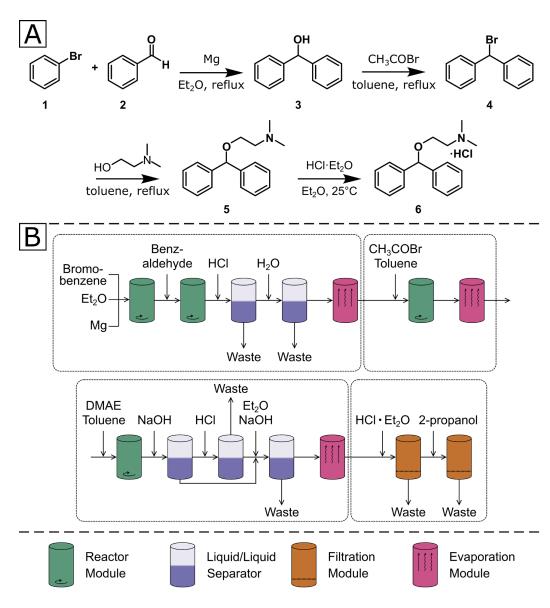2-(Diphenylmethoxy)-N,N-dimethyl-ethanamin-hydrochlorid Chemische Eigenschaften,Einsatz,Produktion Methoden
R-S?tze Betriebsanweisung:
R22:Gesundheitssch?dlich beim Verschlucken.
S-S?tze Betriebsanweisung:
S36:DE: Bei der Arbeit geeignete Schutzkleidung tragen.
Beschreibung
Diphenhydramine is most commonly used as a first-generation antihistamine and is globally marketed in various brand formulations (Benadryl®, Unisom®, Tylenol®, Zzzquil®). It competitively blocks H1 receptors, thereby preventing the actions of histamine on bronchial smooth muscle, capillaries, and gastrointestinal (GI) smooth muscle. This prevents histamine-induced bronchoconstriction, vasodilation, increased capillary permeability, and GI smooth muscle spasms. Diphenhydramine exhibits anti-tussive, antiemetic, sedative, anti-allergic, and anticholinergic activities.
Chemische Eigenschaften
White or almost white, crystalline powder. odorless and has a bitter, numbing taste. soluble in water and in alcohol.
Verwenden
Diphenhydramine is a H1-histamine receptor antagonist with anticholinergic (drying) and sedative side effects. It is categorized as an antihistaminic; sedative, hypnotic, treatment of allergic. It is used to treat allergy and cold symptoms such as sneezing, runny nose, watery eyes, urticaria (hives), skin rash, and pruritus (itchy skin).
Application
Diphenhydramine hydrochloride is used as an antihistamine and for its antieholinergie (drying) and sedative effects; for allergic conjunctivitis due to foods; for mild, uncomplicated allergic skin manifestations of urticaria and angioedema; for amelioration of allergic reactions to blood or plasma; for dermatographism; in therapy for anaphylaetie reactions adjunctive to epinephrine and other standard measures after the acute manifestations have been controlled; for active and prophylactie treatment of motion sickness; for parkinsonism; an antiemetic; has local anesthetic properties; in preparations for the relief of cough; in the prevention and treatment of radiation sickness, nausea and vomiting; for treatment of allergie cheilitis and stomatitis.
synthetische
Diphenhydramine Hydrochloride synthesis is a four-step sequence starting with a Grignard reaction.

Synthesis of Diphenhydramine Hydrochloride 6.
A) modified synthetic route to diphenhydramine hydrochloride.
B) Sequence of unit operations required for the synthesis. The dotted boxes denote the four stages of the synthesis. DMAE: dimethylaminoethanol.
Organic synthesis in a modular robotic system driven by a chemical programming language
Definition
ChEBI: Diphenhydramine Hydrochloride is the hydrochloride salt form of diphenhydramine, an ethanolamine and first-generation histamine antagonist with anti-allergic activity.
Allgemeine Beschreibung
Diphenhydramine hydrochloride(Benadryl), is an oily, lipid-soluble free base available as the bitter-tasting hydrochloride salt, which is a stable, White or almost-white crystalline powder. Odorless with a bitter numbing taste. soluble in water (1:1), alcohol (1:2) and chloroform (1:2). The salt has a pKa value of 9, and a 1% aqueous solution has a pH of about 5.
Air & Water Reaktionen
Water soluble. Aqueous solutions are acidic.
Reaktivit?t anzeigen
N-(2-Diphenylmethoxyethyl)-N,N-dimethylamine hydrochloride gives acidic solutions in water. Neutralizes bases. May react with strong oxidizing and strong reducing agents. May catalyze organic reactions. Slowly darkens on exposure to light.
Health Hazard
Potentially. If taken in large quantities, diphenhydramine can cause severe agitation and confusion, fever, skin flushing, problems with vision, dry mouth, dry eyes, and inability to sweat. Overdoses can lead to high heart rates, abnormal heart rhythms, seizures, and death.
If given to elderly patients, diphenhydramine can cause confusion and agitation. Because of this, diphenhydramine is not recommended in elderly patients for insomnia or treatment for the common cold; though it should still be given in cases of allergic reaction.
Biologische Aktivit?t
Diphenhydramine (DPH) is a first generation antihistamine that is a potent antagonist of the histamine H1 receptor (Ki = 11.7 nM using human recombinant receptors). DPH readily crosses the blood-brain barrier and produces diverse cognitive and psychomotor effects. DPH also antagonizes muscarinic cholinergic receptors (Kis = 100 to 260 nM for M1-M5), increasing the range of central nervous system effects and applications.
Biochem/physiol Actions
Diphenhydramine hydrochloride (DPH) is an antihistaminic agent that relieves symptoms of hypersensitive reactions. It exhibits antimuscarinic and marked sedative effects. DPH is also used to prevent nausea, vomiting and vertigo of various causes. In addition, it acts as a potential therapeutic for insomnia.
Kontakt-Allergie
This antihistaminic drug with sedative properties is
mainly sold over the counter. It can be used both topically
(treatment of pruritis) and orally for its antiallergic,
antiemetic, sedative, and anticough properties.
Allergic or photoallergic contact dermatitis and fixeddrug
eruption seem to be rare.
Sicherheitsprofil
Poison by ingestion,
subcutaneous, intravenous, and
intraperitoneal routes. Human systemic
effects by ingestion or skin contact:
arrhythmias, ataxia, blood pressure
elevation, convulsions, distorted
perceptions, eye effects, and hallucinations.
Experimental teratogenic and reproductive
effects. Questionable carcinogen with
experimental tumorigenic data. When heated
to decomposition it emits very toxic fumes
of NO, and HCl. See also ESTERS and
ETHERS.
2-(Diphenylmethoxy)-N,N-dimethyl-ethanamin-hydrochlorid Upstream-Materialien And Downstream Produkte
Upstream-Materialien
Downstream Produkte

